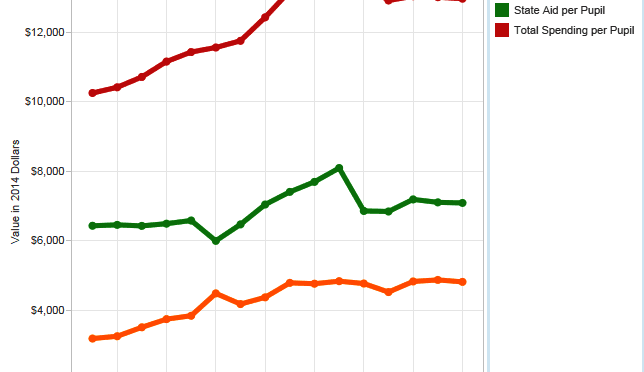Category: Wichita and Kansas schools
-

Wichita schools seek to rebrand
While poormouthing and suing taxpayers for more money, the Wichita school district wants to spend on a rebranding and marketing campaign.
-

Kansas school finance case based on inadequate standards
The just-released Gannon school finance decision in Kansas concludes that not long ago Kansas schools were functioning adequately. But data on Kansas school standards says something else.
-
Are Kansas classroom sizes growing?
On his blog, former Kansas state budget director Duane Goossen writes: ?Lawmakers do have discretion over general state aid, and they have chosen to let it decline. The result: classroom sizes are growing and Kansas districts are less able to competitively attract and retain high-caliber teachers.? Here’s the data, fresh from Kansas State Department of…
-

Kansans still uninformed on school spending
As in the past, a survey finds Kansans are uninformed or misinformed on the level of school spending, and also on the direction of its change.
-

Kansas school teacher cuts, student ratios
What has been the trend in Kansas school employment and pupil-teacher ratio?
-

In Kansas, school employment rises again
For the fourth consecutive year, the number of teachers in Kansas public schools has risen faster than enrollment, leading to declining pupil-teacher ratios.
-

Kansas school spending visualization updated
There’s new data available from Kansas State Department of Education on school spending. I’ve gathered the data, adjusted it for the consumer price index, and now present it in this interactive visualization. Click here to open the visualization in a new window.
-
Kansas school spending and achievement
From Dr. Walt Chappell, a discussion of Kansas school spending. Chappell served on the Kansas State Board of Education from 2009 to 2012.
-

Kansas school spending updated for 2014
Updated figures for Kansas school spending are now available from the Kansas State Department of Education.
-

Kansas school fund balances
Kansas school fund balances declined this year, but fund balances are still large.
-

Kansas schools shortchanged
Kansas schools could receive $21 million annually in federal funds if the state had adequate information systems in place.
-

Kansas school claims, numbers don’t match
Kansas school spending advocates make claims of exploding class sizes that aren’t reflected in enrollment and employment data